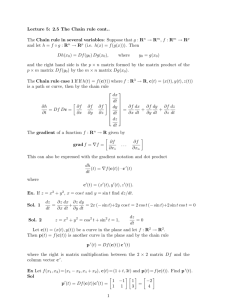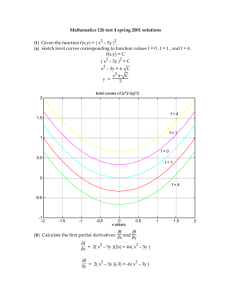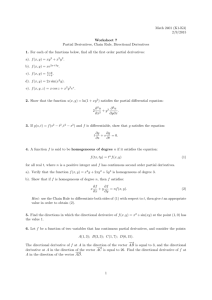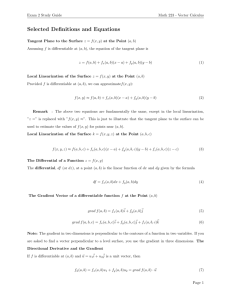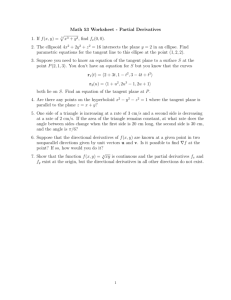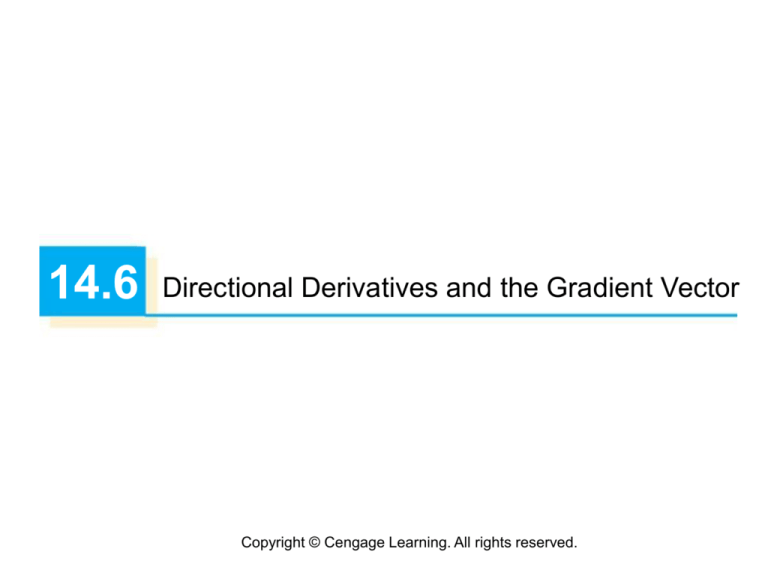
14.6
Directional Derivatives and the Gradient Vector
Copyright © Cengage Learning. All rights reserved.
Directional Derivatives
2
Directional Derivatives
When we compute the directional derivative of a function
defined by a formula, we generally use the following
theorem.
3
Directional Derivatives
If the unit vector u makes an angle with the positive
x-axis (as in Figure 2), then we can write u = cos , sin
and the formula in Theorem 3 becomes
Duf(x, y) = fx(x, y) cos + fy(x, y) sin
Figure 2
A unit vector u = a, b = cos , sin
4
5
The Gradient Vectors
6
The Gradient Vectors
Notice from Theorem 3 that the directional derivative of a
differentiable function can be written as the dot product of
two vectors:
Duf(x, y) = fx(x, y)a + fy(x, y)b
= fx(x, y), fy(x, y) a, b
= fx(x, y), fy(x, y) u
The first vector in this dot product occurs not only in
computing directional derivatives but in many other
contexts as well.
So we give it a special name (the gradient of f ) and a
special notation (grad f or f, which is read “del f ”).
7
The Gradient Vectors
8
Example 3
If f(x, y) = sin x + exy, then
f(x, y) = fx, fy
= cos x + yexy, xexy
and
f(0, 1) = 2, 0
9
The Gradient Vectors
With this notation for the gradient vector, we can rewrite the
expression (7) for the directional derivative of a
differentiable function as
This expresses the directional derivative in the direction of
u as the scalar projection of the gradient vector onto u.
10
Functions of Three Variables
11
Functions of Three Variables
If f(x, y, z) is differentiable and u = a, b, c, then
Duf(x, y, z) = fx(x, y, z)a + fy(x, y, z)b + fz(x, y, z)c
For a function f of three variables, the gradient vector,
denoted by f or grad f, is
f(x, y, z) = fx(x, y, z), fy(x, y, z), fz(x, y, z)
or, for short,
12
Functions of Three Variables
Then, just as with functions of two variables, Formula 12 for
the directional derivative can be rewritten as
13
14
Example 5
If f(x, y, z) = x sin yz, (a) find the gradient of f and (b) find
the directional derivative of f at (1, 3, 0) in the direction of
v = i + 2 j – k.
Solution:
(a) The gradient of f is
f(x, y, z) = fx(x, y, z), fy(x, y, z), fz(x, y, z)
= sin yz, xz cos yz, xy cos yz
15
Example 5 – Solution
cont’d
(b) At (1, 3, 0) we have f(1, 3, 0) = 0, 0, 3.
The unit vector in the direction of v = i + 2 j – k is
Therefore Equation 14 gives
Duf(1, 3, 0) = f(1, 3, 0) u
16
17
Maximizing the Directional
Derivatives
18
Maximizing the Directional Derivatives
Suppose we have a function f of two or three variables and
we consider all possible directional derivatives of f at a
given point.
These give the rates of change of f in all possible
directions.
We can then ask the questions: In which of these directions
does f change fastest and what is the maximum rate of
change? The answers are provided by the following
theorem.
19
Example 6
(a) If f(x, y) = xey, find the rate of change of f at the point
P(2, 0) in the direction from P to
.
(b) In what direction does f have the maximum rate of
change? What is this maximum rate of change?
Solution:
(a) We first compute the gradient vector:
f(x, y) = fx, fy = ey, xey
f(2, 0) = 1, 2
20
Example 6 – Solution
cont’d
The unit vector in the direction of
= –1.5, 2 is
u=
so the rate of change of f in the direction from P
to Q is
Duf(2, 0) = f(2, 0) u
(b) According to Theorem 15, f increases fastest in the
direction of the gradient vector f(2, 0) = 1, 2.
The maximum rate of change is
|f(2, 0)| = | 1, 2 | =
21
Tangent Planes to Level Surfaces
22
Tangent Planes to Level Surfaces
Suppose S is a surface with equation F(x, y, z) = k, that is,
it is a level surface of a function F of three variables, and let
P(x0, y0, z0) be a point on S.
Let C be any curve that lies on the surface S and passes
through the point P. Recall that the curve C is described by
a continuous vector function r(t) = x(t), y(t), z(t).
Let t0 be the parameter value corresponding to P; that is,
r(t0) = x0, y0, z0. Since C lies on S, any point (x(t), y(t),
z(t)) must satisfy the equation of S, that is,
F(x(t), y(t), z(t)) = k
23
Tangent Planes to Level Surfaces
If x, y, and z are differentiable functions of t and F is also
differentiable, then we can use the Chain Rule to
differentiate both sides of Equation 16 as follows:
But, since F = Fx, Fy, Fz and r(t) = x(t), y(t), z(t),
Equation 17 can be written in terms of a dot product as
F r(t) = 0
24
Tangent Planes to Level Surfaces
In particular, when t = t0 we have r(t0) = x0, y0, z0, so
F(x0, y0, z0) r(t0) = 0
Equation 18 says that the gradient vector at P, F(x0, y0,
z0), is perpendicular to the tangent vector r(t0) to any curve
C on S that passes through P. (See Figure 9.)
Figure 9
25
Tangent Planes to Level Surfaces
If F(x0, y0, z0) 0, it is therefore natural to define the
tangent plane to the level surface F(x, y, z) = k at
P(x0, y0, z0) as the plane that passes through P and has
normal vector F(x0, y0, z0).
Using the standard equation of a plane, we can write the
equation of this tangent plane as
26
Tangent Planes to Level Surfaces
The normal line to S at P is the line passing through P
and perpendicular to the tangent plane.
The direction of the normal line is therefore given by the
gradient vector F(x0, y0, z0) and so, its symmetric
equations are
27
Tangent Planes to Level Surfaces
In the special case in which the equation of a surface S is
of the form z = f(x, y) (that is, S is the graph of a function f
of two variables), we can rewrite the equation as
F(x, y, z) = f(x, y) – z = 0
and regard S as a level surface (with k = 0) of F. Then
Fx(x0, y0, z0) = fx(x0, y0)
Fy(x0, y0, z0) = fy(x0, y0)
Fz(x0, y0, z0) = –1
so Equation 19 becomes
fx(x0, y0)(x – x0) + fy(x0, y0)(y – y0) – (z – z0) = 0
28
Example 8
Find the equations of the tangent plane and normal line at
the point (–2, 1, –3) to the ellipsoid
Solution:
The ellipsoid is the level surface (with k = 3) of the function
29
Example 8 – Solution
cont’d
Therefore we have
Fx(x, y, z) =
Fy(x, y, z) = 2y
Fx(–2, 1, –3) = –1
Fy(–2, 1, –3) = 2
Fz(x, y, z) =
Fz(–2, 1, –3) =
Then Equation 19 gives the equation of the tangent plane
at (–2, 1, –3) as
–1(x + 2) + 2(y – 1) – (z + 3) = 0
which simplifies to 3x – 6y + 2z + 18 = 0.
By Equation 20, symmetric equations of the normal line are
30





